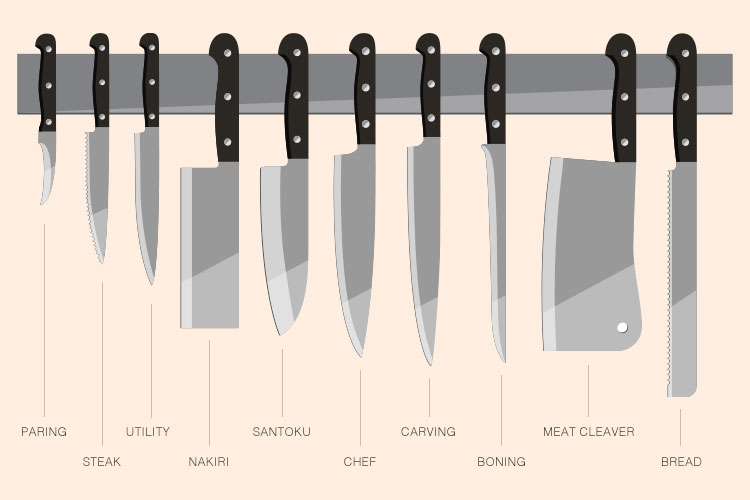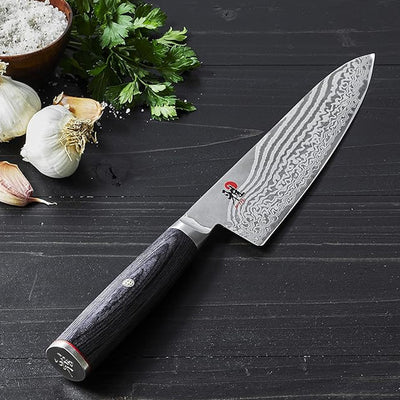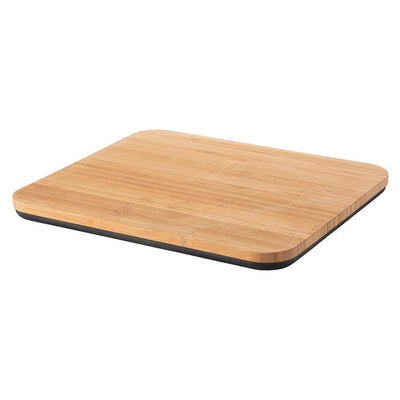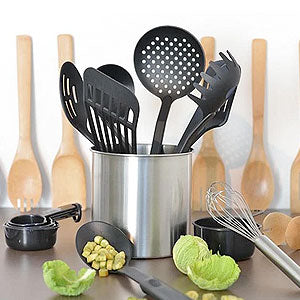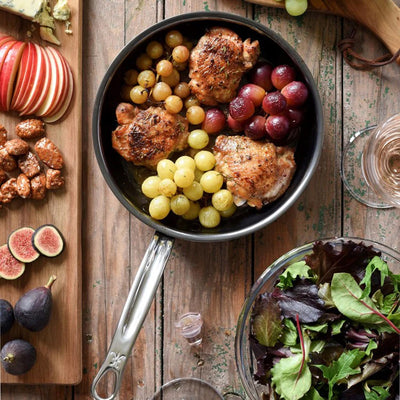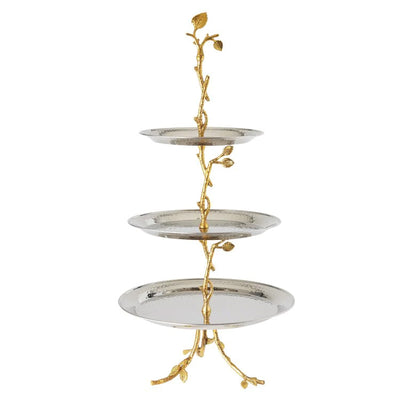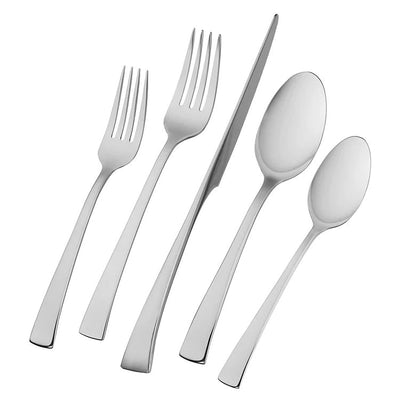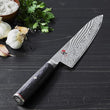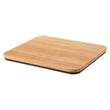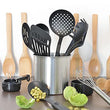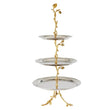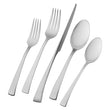Cutlery Buying Guide
Choosing the Right Knife for the Job
Knives are the work horses of any kitchen and one of the most important things you can purchase to improve your cooking skills. Any way you slice it, culinary experts depend on their knives to help them get the job done. Knives are something you will use every day to dice, slice, carve, and cut a variety of meats, vegetables, fruits, cheeses, etc. as you prepare the foods for each meal. There’s a knife designed to tackle every culinary task, and this kitchen cutlery buying guide will help you choice the right knife for the job.

There's a knife designed to tackle every culinary task.
The Anatomy of Cutlery
Blade
Knife blades come in various shapes and sizes. Each shape is created with a specific task in mind. Chopping blades, for example, will be more rounded in order to give the knife the ability to rock back and forth on the cutting surface to make chopping and dicing easier.
Cutting Edge
The cutting edge is the sharpened part of the blade that does the actual cutting.
Spine
The spine is the top edge of the blade. It provides strength and weight to the knife. It usually is thicker closer to the handle and tapers to a thin edge near the tip.
Bolster
The bolster is the balancing point located between the blade and the handle. It provides balance, support, and helps protect fingers.
Tang
The tang is the portion of the knife that is enclosed by the handle. Higher quality knives will have a full tang that runs the entire length of the handle to provide better balance, strength, and durability.
Handle
The handle is the portion you hold and should provide a secure and comfortable grip. An ergonomically shaped handle will help reduce hand fatigue while cutting. Handles can be made of a variety of materials and styles. The more seamless its construction, the easier it will be to keep clean.
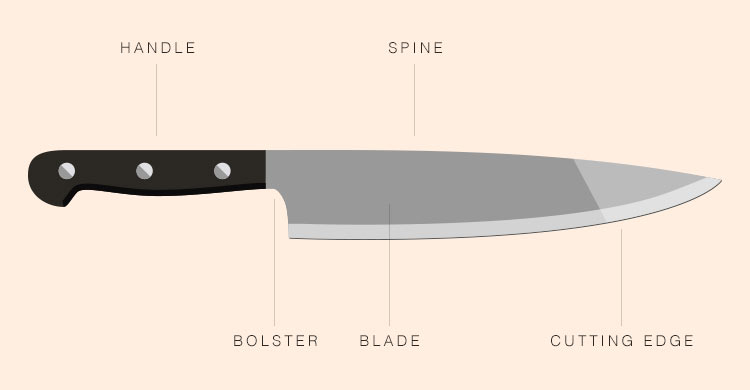
The Anatomy of Cutlery
Common Types of Knives and Their Uses
Having the right selection of knives will make a world of difference in the preparation, presentation, and even outcome of your cooking. When you use the right knife for its appointed task, you’ll achieve results faster, easier, and more efficiently so you spend less time preparing a meal and more time enjoying eating it. Here is a breakdown of the most common types of knives found in both professional and home kitchens and their uses.
Chef's Knife
The multi-tasking chef’s knife is one knife you’ll use every day. Also known as a cook’s or chef’s kitchen knife, this all-purpose knife is one of the most important and versatile knives in your kitchen. It comes in a variety of lengths from 5” to 10” and can be used to chop vegetables, cut up and slice meat, mince herbs, dice onions, and tackle most cutting jobs. Choose one that feels balanced and comfortable in your hand.
Santoku Knife
Named for the Japanese word meaning “three benefits,” the Santoku knife is a must-have for the busy cook. Because it cuts cleanly and precisely, it will easily assist you in a variety of food preparation. Its blade is designed so you cut with a back and forth slicing motion or a straight-down chopping motion to mince, dice, and slice practically any ingredient.
Nakiri Knife
Another traditional Japanese knife, the Nakiri knife is shaped like a cleaver but with a more slender profile. Its sharp, balanced design makes it perfect for precision dicing, slicing, and mincing. The side of the blade can also be used to scoop up the chopped ingredients to transfer them from the cutting board to the pan or bowl.
Slicing/Carving Knife
Long and slender, these classic knives are designed to quickly and easily slice and carve foods into uniform portions. It’s ideal for cutting meats, poultry, fish, and more before serving. The tip may be pointed or rounded, depending on its purpose.
Paring Knife
The versatile size and shape of the paring knife makes it an indispensable tool in any cook’s arsenal. Featuring a short blade measuring from 2” to 4-1/2” long, this little but mighty knife functions like a mini chef’s knife, allowing you to cut, peel, slice, trim, and dice fruit and vegetables, smaller pieces of meat, and more. It’s great for coring and hulling fruits, deveining shrimp, and creating decorative garnishes.
Utility Knife
Another all-purpose tool in any cutlery set, the utility knife is sized between the chef’s knife and a paring knife. It can have either a straight end or a serrated blade, making it a great choice for chopping, mincing, and slicing produce, slicing bagels, or cutting a sandwich in half for lunch.
Serrated Bread Knife
When it comes to slicing bread without squishing the interior, the serrated edge of the bread knife makes the cut. Its long, narrow blade saws through any type of loaf using sharp serrations to cut cleaning through thick crusts and soft centers. Besides handling anything from crusty artisan breads to bagels, soft rolls, and loaves right out of the oven, the bread knife is great for slicing tomatoes and citrus fruits without crushing them.
Boning Knife
As the name implies, a boning knife is designed for meat and poultry preparation, specifically to separate the meat from the bones and cartilage in raw meats. It features a sharp, slender blade that maneuvers easily, makes precise cuts, and is perfect for trimming cuts of meats.
Meat Cleaver
The sturdy meat cleaver is a powerful and well-balanced knife that makes fast work of chopping larger cuts of meat and poultry. Its finely honed blade will cut easily and cleanly through flesh, bones, and tendons in a single stroke. Some chef’s also find cleavers the tool to use when they want to quickly chop and mince thick, firm vegetables such as carrots, potatoes, and other root vegetables.
Fillet Knife
Fillet knives have thin tapered blades that are very flexible and extremely sharp. This type of knife is designed to glide around delicate fish bones to cut fillets and also easily slide under the skin to remove it from the flesh.
Tomato Knife
This specialty knife’s serrated edge easily cuts tomatoes into neat slices without tearing the delicate skin or crushing the pulpy center of even the ripest fruit. The knife also features a pronged tip that’s handy for spearing slices to transfer them from the cutting board to the plate or platters.
Steak Knife
A steak knife is a sharp table knife used for cutting steak and other meat while eating. They can have smooth or serrated edges or a combination of both. They can have handles made from a variety of materials such as wood, plastic, or metal.
Kitchen Shears
A handy item to have, kitchen shears or scissors have short, sharp blades that can be used to snip herbs, cut string from roasts, open sealed food wrappings, make quick, even slices of small items like green onions, and trim pastry dough around a pie plate. Some even have a built-in bottle opener on the handles. Most designs have blades that pull apart for easier cleaning.
Cutlery Sets
Cutlery sets conveniently include the most frequently used knives in one set. Many come complete with their own knife block for handy storage and access on the counter or next to the stove. You can start with the basic types you use the most and add individual pieces for more specialized cutting tasks. Most cutlery sets will include a paring knife, a chef’s knife, a bread knife, a carving knife, a utility knife, and a Santoku knife. Depending on the size of the set, it can also include a fillet knife or boning knife, a pair of shears, a sharpener, and some steak knives.
Quality Construction Matters
As a tool you will use every day, you want to buy the best quality knives you can afford. The better quality knives not only work better, they will last longer. Start with the size and types you use the most and add to your cutlery set as your budget allows. View it as an investment as a well-made knife will last a lifetime.
Forged Construction
A forged knife is made from a single sheet of metal or steel that is heated and hammered into shape. Forged knives will have a bolster or wide lip where the blade meets the handle and a full or partial tang. The forging process is more labor intensive, thus these knives are more expensive to produce.
Stamped Construction
Stamped knives have blades that have been stamped or pressed from sheets of steel much like a cookie cutter. The blades are fitted into the handle instead of being created in one continuous piece and thus have no tang. They lack the balance and strength of a forged knife and require a firmer grip and more pressure when in use. They will cost less than forged knives.
Carbon Steel
Many knives are made of carbon steel. This strong metal alloy has a tight grain structure that is capable of achieving a sharper edge than stainless steel. Carbon is reactive to acids and will develop a patina over time which protects the blade and acts as a non-stick layer. It can rust easier than stainless steel, so it’s crucial to keep your blades dry and oiled when not in use.
Stainless Steel
Stainless steel requires less upkeep than carbon steel and is not as reactive to different products. It will not develop a patina and does not need oiling after cleaning to maintain its integrity. The matte finish acts as the non-stick barrier, allowing the blade to effortlessly pass through foods. While sharp, it will not achieve as sharp an edge as carbon steel.
VG10 Steel
VG10 steel is produced in Japan and sets the “gold standard” for high-end cutlery. It not only withstands rust, but has the ability to maintain a very sharp edge, making it prized among professional chefs.
Keep Your Cutlery in Top Condition
Learning how to care for your fine cutlery will prolong the life of your knives and ensure their excellent performance.
Cutting Boards
Cutting boards not only protect your countertop surface, but also can prolong the life of your cutlery blades, so you should always use one when cutting any food with your knives. Choose a board made from a resilient wood such as bamboo, maple, or ash, a synthetic, or composite material such as polypropylene. These materials have a bit of “give” to them as the blade cuts across them, protecting the blade from damage. Avoid cutting boards made of metal, glass, stone, or marble as these harder materials will dull and eventually damage your knife blades.
Cleaning
Even though some manufacturers will say their cutlery is dishwasher safe, you should handwash your good-quality cutlery in order to keep it in optimum condition. The abrasives used in dishwasher detergent will tend to dull or pit the blade edges, shortening the lifetime of your knives. Also many plastics and woods used on the handles would be damaged by the high heat and prolonged contact with water from dishwashers. To keep your blades looking and working their best, handwash them in warm, soapy water with a non-abrasive sponge or cloth after use. Never leave knives soaking in water for long periods. After washing, dry them immediately, and store them in the block, in a knife roll/wrap, in a protective sleeve, or a cutlery case.
Honing/Sharpening
Invest in a good-quality honing stone or knife sharpener to keep your blades sharp. A sharp knife is actually safer to use because it makes it easy to control how the blade moves through food as you chop and slice. A dull blade can slip or make control difficult, increasing the risk of cutting your finger. Whenever the blade appears to be dull, use the knife hone (either a handheld steel rod or a ceramic/stone block) or sharpener to bring the blade back to a razor edge.
Storage/Blocks
Store your knives in a block, a drawer fitted with a special cutlery insert, on a magnetic knife strip, or in individual plastic or silicone knife sheaths to protect the blades from damage. Tossing them loose in a cabinet drawer can lead to dull or damaged blades, and also increases the chance of injury from cutting a finger while reaching in to grab a knife from the drawer.
If you are looking for a starter set, want to upgrade your cutlery, or add some specialty knives to your collection, check out the cutlery selection at Riverbend Home. We carry a variety of top-quality brands such as Shun, J.A. Henckels, French Home, Jean Dubost, and more in a wide range of styles, designs, and types.

